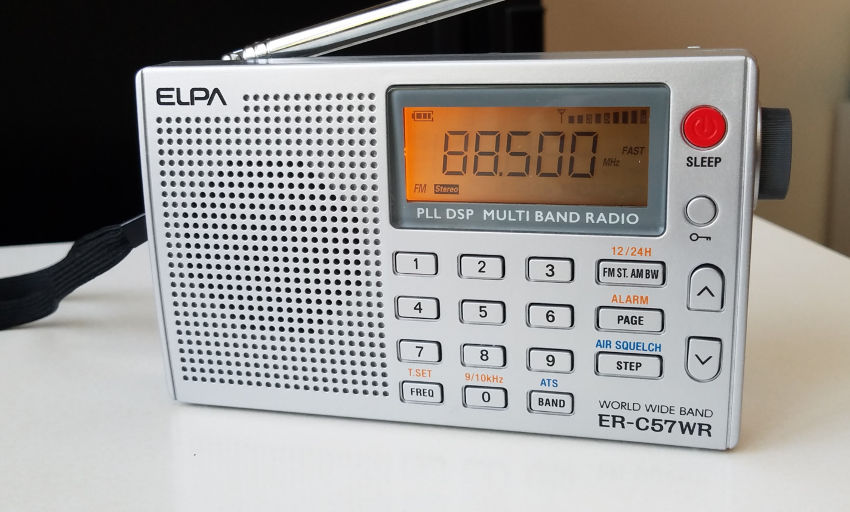
This radio first came to my attention through a brief article on The SWLing Post toward the end of 2016. The article mentioned indicated a superficial resemblance to the C. Crane CC Skywave radio. However, at the end of 2019, I could find no reviews for this radio, at least in English, Spanish, or French.
I very much liked the look of the radio - I wish more models came in a metallic silver finish. Tecsun does offer some radios in this color (I have the Tecsun PL-505 and the Tecsun PL-606 in silver), but other manufacturers have stuck with dark gray or black. I guess those are the "colors" of the moment, but it gets boring after a while. I really like the look of silver-colored audio equipment, and hope it will make a comeback.
Long story short, I found the radio for sale on Amazon through a reseller, and bought it for around $70.
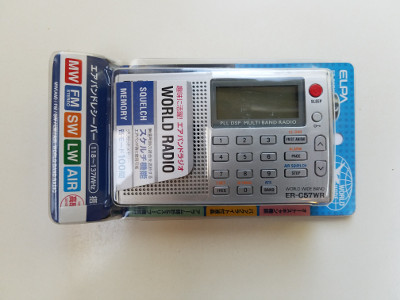
On arrival (see blister pack at left), it became obvious why this radio isn't more widely known. It's primarily sold only in Japan. The name of the reseller was "ClickJapan", so that wasn't a total surprise. But it really is intended for the Japanese domestic market. The specifications are given entirely in Japanese, and the owner's manual is also entirely in Japanese. The only sentence in English in the entire owner's manual is, "This warranty is valid only in Japan."
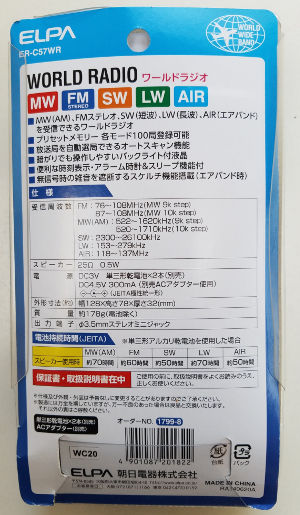
Fortunately, the text for the controls is all in English. There's direct keypad entry for memory settings and, if the keypad entry is preceded by a press of the FREQ button, the frequency of a desired station can be entered directly as well. Tuning is done either with a knob on the right side of the unit, or with up and down buttons, or through memory settings. An automatic search function is provided.
Switching between bands has to be done through repeated presses of the BAND button, cycling through the FM, longwave, AM, shortwave, and aircraft bands. The Radiwow R-108 takes the same approach.
It does not appear that longwave reception can be turned off. Compare that situation to other DSP-based radios that permit deactivating longwave-band reception. I have yet (as of the end of 2019) to find a DSP-based radio that performs even at a minimal level on that band.
Switching between bands is fast, with only a brief pause in the audio before reception resumes.
The radio can be set to toggle between 9 kHz and 10 kHz (used in the Western Hemisphere) spacing for the AM and shortwave bands by pressing the zero button on the numeric keypad when the radio is off.
You may be wondering if the radio tunes only the Japanese FM band, from 76-90 MHz, rather than the 87 or 88 MHz to 108 MHz used in the rest of the world. It can tune both ranges, as pressing the zero button to set AM station spacing also sets the FM frequency range. If 9 kHz spacing is selected, the FM band is set to range between 76-108 MHz, which covers all possibilities except for the FM band still in use in some former Soviet-dominated countries. If 10 kHz spacing is selected, the range for FM reception is set between 87 and 108 MHz.
There's a lock button as well as a yellow backlight that stays on for a very brief period of time after any button is pushed.
I wasn't able to find any unlabeled functions on the radio, which on some other DSP-based radios are found on the numeric keypad, activated when the radio is nominally "off".
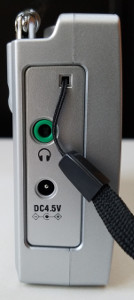
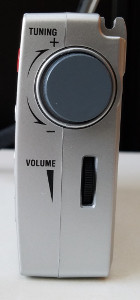
There is what appears to be a very similar radio sold by the Australian electronics retailer Jaycar, the Digitech AR-1733. I checked out the manual for the AR-1733, found online, and did not see any reference to functions that weren't also present on the Elpa unit, except for battery charging capability. The Elpa radio can't charge batteries, as far as I can tell, while the Digitech AR-1733 can do so.
The Elpa ER-C57WR requires two "AA" batteries, and can also accept an external power supply, as seen at the far left photo, showing the left side of the unit, where the headphone jack is located. When listening with headphones, FM reception is in stereo. There's the option of turning off stereo reception by pressing the FM ST. AM BW button.
The right side of the unit, shown at the immediate left, has the tuning knob and volume control. Pressing in on the tuning toggles between broad tuning steps and more precise steps.
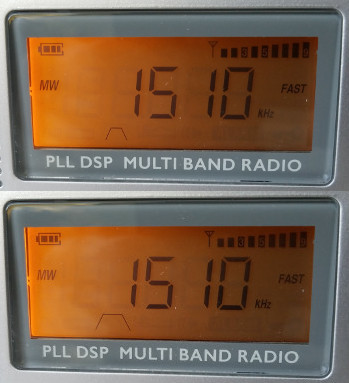
The FM ST. AM BW button, mentioned above, is also used to select two audio bandwidths for listening to the AM, longwave, or shortwave bands. This is fewer than most DSP-based radios of this size. The bandwidth indicator is very different from that of any other radio I've seen. In other DSP-based radios, you get a numeric readout of the bandwidth only when you have cycled through the bandwidth selections. Shortly after selecting a bandwidth, the radio returns to whatever it was displaying before.
On the Elpa radio, the indicator is always active, unless tuned to the FM band, where it would be unnecessary anyway. The indicator is graphical in nature, as shown by the photos at right. You'll have to look carefully to find it: it's a narrow line at the bottom of the display, above the letters DSP MULTI. The upper display indicates that the radio's audio bandwidth is in the narrow mode; the lower one shows that the radio's audio bandwidth is wide.
The two AM bandwidth modes are not much different. After writing the initial version of this review, I measured the radio's frequency response on AM. I measured the audio bandwidth in the radio's wide position at around 5.5 kHz, while the narrow position allows for 4 kHz of bandwidth. Those choices are good for pleasant listening, considering the limitations of the radio's 1 1/2"-diameter speaker (same size as the CC Skywave's speaker), but hobbyists who listen to distant stations will want additional choices with narrower bandwidths to filter out interference from adjacent stations.
I'll note that, before DSP-based portable radios came along, having two audio bandwidths on a receiver was a high-end feature, which many good radios did not have. The advent of DSP-based radios has reset expectations, both for this feature and for FM reception. Interesting, all but a very few DSP-based radios have continued to stick with one bandwidth for FM reception.
Since it looks like the CC Skywave, does it perform like the CC Skywave? In a head-to-head comparison at my San Francisco Bay Area location, with the region's crowded AM and FM dials, the two units receive a comparable number of stations, with just about the same signal strength except in the uppermost reaches of the AM band, where the Skywave does a better job.
On AM, the Elpa doesn't do as good a job as the Skywave in maintaining a constant volume despite variations in signal strength (i.e., audio recovery). It's still decent, but the Skywave is better.
On FM, the Skywave is able to lock onto weaker stereo signals quicker than the Elpa, and is able to hold that lock to a greater degree. The two radios have incorrectly-sized (for FM) rod antennas of roughly the same length: 19 3/8" for the Elpa and 19 1/2" for the CC Skywave.
A head-to-head comparison with the Radiwow R-108 gave similar results. The Radiwow had much better sound from its built-in speaker, compared to both the Elpa and the Skywave. The Elpa lacks the "music/voice" filter that the Skywave and the Radiwow have for taming the overly bright sound that a small speaker can have. Thus, the sound you get from the built-in speaker can really only be improved by plugging in good headphones and listening that way.
By the way, the Elpa does not come with earbuds, nor with a carrying case. As with the Radiwow R-108, the Japanese discount store Daiso offers a reasonable substitute for $1.50. (See the Radiwow R-108 review for a photo.)
Twenty years ago, the Elpa would have been considered a great radio, albeit with a tinny-sounding speaker. With DSP-based radios becoming common, there are now radios that are even better. Because of its price, currently running around $65 plus shipping, when considered alongside its features and perfomance, as well as its limited distribution, the Elpa probably has to be considered something of a novelty item. I like the looks of it, and the radio is perfectly serviceable, but I have other radios that perform just a little better and have more features. Some of those radios are a little less expensive, some of them a little more. To summarize, I feel that similar radios in this class offer better value for money than the Elpa ER-C57WR. But it's still a handsome radio!